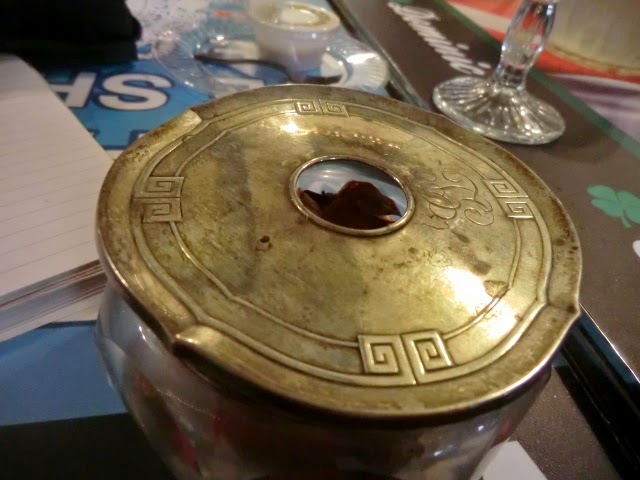| Another view of the walls, with loads of memorabilia and paintings.
Before Curt’s presentation, we enjoyed a delicious dinner with the Lions. While we indulged in our dessert, the meeting started with Curt’s presentation.
Curt gave a brief history of Grand Island and of the Grand Island Historical Society. He said that the Town of Grand Island was incorporated in 1852. In the nineteenth century, big businesses on Grand Island included ice harvesting and logging.
Lewis F. Allen, for whom Allen Street and Allentown in the City of Buffalo were named, was somehow involved with the Whitehaven Settlement in Grand Island. He also owned a farm on the southern tip of Grand Island, called “Allenton Farms.” The Whitehaven Settlement was where a massive logging operation was held. There were ten to twelve steam sawmills, staffed by “gangs of men,” Curt said.
At the time, clear cutting was seen as acceptable, even if the trees being removed in massive number were trees that grew slowly and could not be easily replaced. Today, we call that “deforestation” and we understand that is a very bad idea. But, back in the nineteenth century, the white oak that covered Grand Island was seen as a resource to be used, rather than as a treasure to be maintained. Grand Island originally had 17,000 acres of white oak. Sixteen thousand acres were logged off, and the trees were turned into mastheads for ships.
The Grand Island Historical Society was founded in 1962 to protect River Lea from being torn down, as were most of the houses that were on land that was taken over by the state. That land became Beaver Island State Park.
Below are some of the objects that Curt brought to the meeting.
This object is a bed warmer. People in the 19th century did not have central heating in their houses so their beds got cold. The only room that was heated in the winter was the kitchen because that was where the stove was located. Other rooms became cold. With this object, people could feel warm in bed. Of course, there are other ways to feel warm in bed, which was probably why the birth rates in the nineteenth century remained consistently high. Unfortunately, the infant mortality rates were also high. Hence the need to have lots of children (to work on the farm).
People in the nineteenth century were very frugal. According to Curt, “Nothing was wasted. Everything was used.” The object above is called hair art. When women brushed their hair, they took the hair out of their brushes and placed the hair into a hair holder. Curt brought one of those to show. When the women had enough hair, they made wreaths with their hair. It is not an art form that is practiced anymore.

This object is called a “tussy mussy.” It is used to hold fragrant flowers. Back in the nineteenth century, people did not bathe regularly nor did they do their laundry very often. Neither activity was easy to accomplish. Taking a bath involved setting up a large bathtub in the kitchen, which, as I previously mentioned, was the warmest room in the house. Water had to be brought in as there was no indoor plumbing. The water had to be heated and then poured into the tub. The whole family bathed in the same bath water. The order for the bath was not oldest to youngest, as I had previously thought. The dirtiest person generally went first. The cleanest washed in all of that dirty bath water. Um. Yuck. I am grateful for a nice clean shower!!!! As for the laundry, it was all done by hand and that was a lot of work.
So… people who don’t bathe often or do their laundry tend to smell bad. They put the fragrant flowers in their tussy mussy and carried the flowers with them. The flowers were supposed to cover up the body odor.
A closer view of the ornate design of the tussy mussy.
This is a silent butler. It is used to clean up crumbs after a dinner party or to clean out ashtrays.
Other objects that Curt displayed included a stereo opticon, a salt keeper, a holder for tiny pieces of soap (because nothing went to waste), a rug beater, a cherry pitter, a hat holder, and an egg scale.
After our display, the Lions went on with their business meeting. I cleared away the displays and the maps, and we left the Lions to their own devices.
It was a good evening, and the Lions expressed fascination with the objects, as well as with stories about local history.
|















I love looking at historical pieces because it interests me that they all have many stories to tell. 🙂